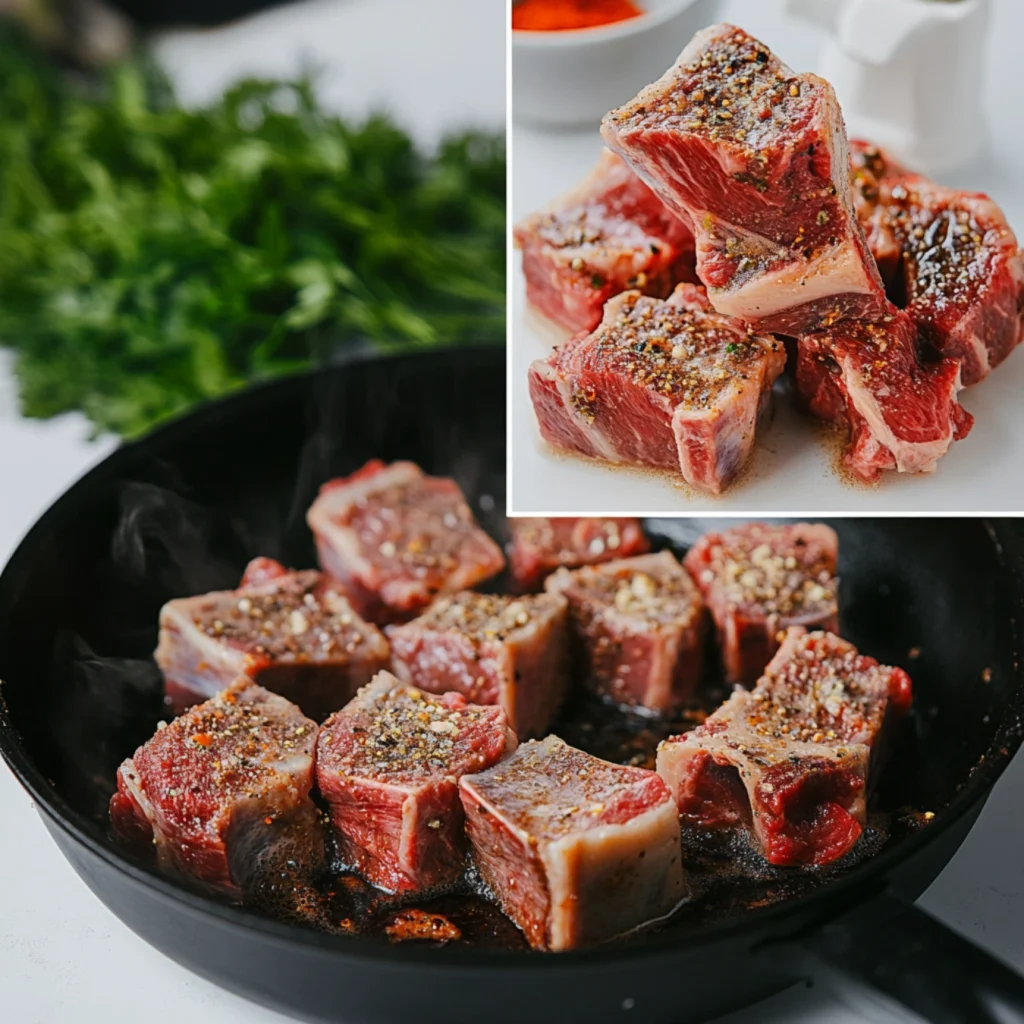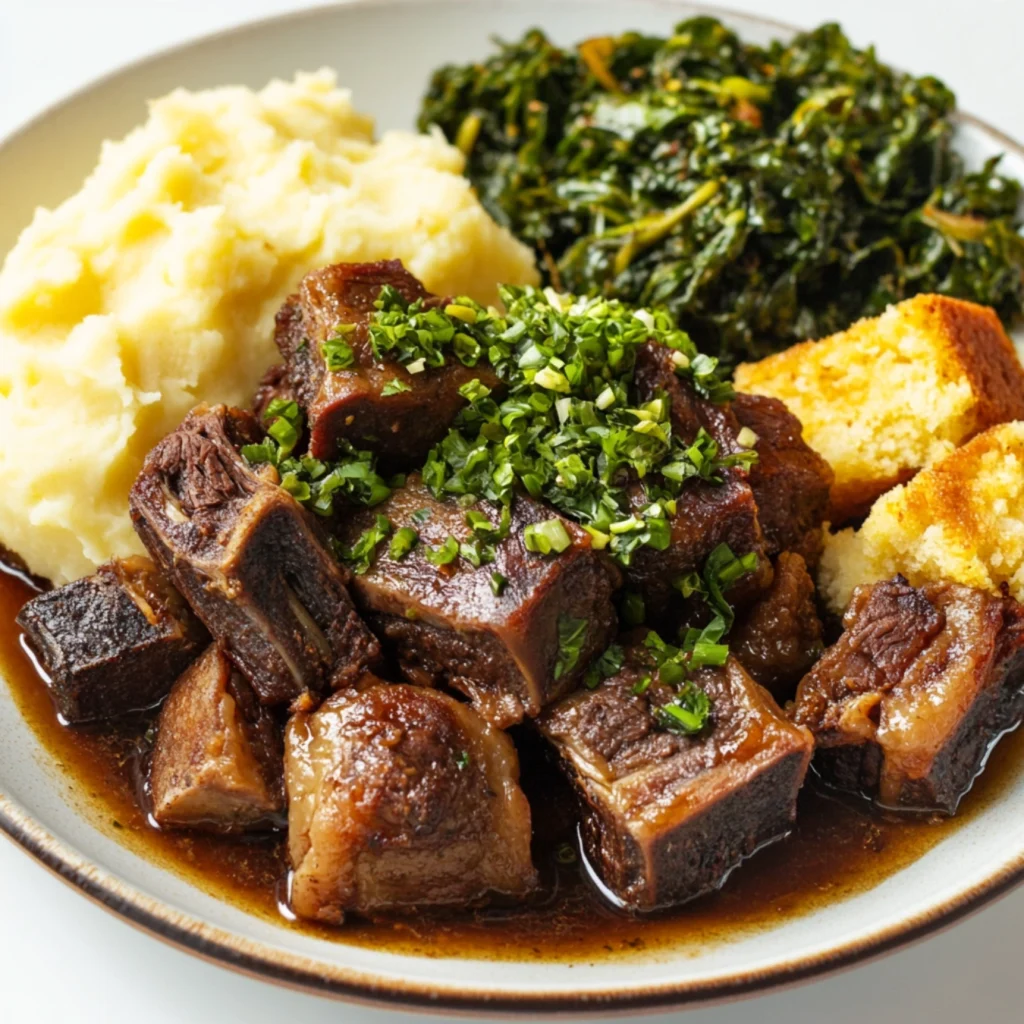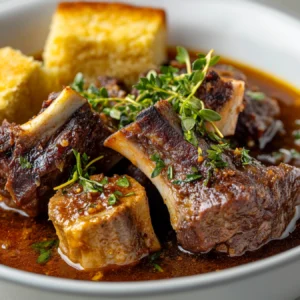You’re in for a treat if you’re searching for a substantial, fall-off-the-bone meal bursting with rich, deep flavors! A comfort food dream, slow-cooked Beef Neck Bones Recipe are supple, juicy, and flavored with a smokey sauce that will have you licking your plate clean. This dish is about letting time do the work; it turns a reasonably priced cut of beef into something rather wonderful. Trust me; once you try this, your kitchen will feature it regularly.
Table of Contents
Why You Will Love This Recipe
Melt-in-Your-Mouth Tender
Slow cooking renders the meat tender and juicy.
Savory Sauce Perfection
The perfect savory sauce comes from smoked Paprika, Worcestershire sauce, and slow-simmered broth.
Economical and Fulfilling
One reasonably priced cut with great taste is neck bones!
One-Pot Wonder
Maximum taste in one pot with simple cleaning.
Ingredients
The Following Will Help You Create Flavorful, Slow-Cooked Beef Neck Bones:
- The main actor in the meal is beef neck bones! Slow-cooked reduces this cut to become quite soft.
- Olive oil adds a great depth of taste and is best-used searing.
- Onion and garlic are a great foundation that gives the broth fragrant excellence.
- Celery and carrots provide richness and texture, therefore enhancing the broth.
- Salt and black pepper are essential for seasoning.
- Smoked Paprika offers a rich, somewhat smokey warmth.
- Dried thyme brings an earthy, herbaceous element.
- Garlic powder brings more general flavorful depth.
- Optional cayenne pepper provides some heat for those who enjoy spices.
- Rich, umami kick is what Worcestershire Sauce offers.
- Tomato paste enlivens and thickens the sauce.
- The cooking liquid that maintains meat’s juiciness and taste is beef broth (or water).
- Apple cider vinegar tenderizes meat brilliantly.
- Bay Leaf gives the food subdued earthy aromas.
- For a vivid, fresh garnish, fresh parsley is great.
👉 The complete ingredient list with measurements is in the recipe card below!
Making Slow-Cooked Beef Neck Bones
First Phase: Get Ready the Meat
Under cold water, rinse the beef neck bones; then, using paper towels, blot them dry.
Second Step: Search for Flavor
Warm olive oil in a Dutch oven or large saucepan set over medium-high heat. Sear the neck bones on all sides till a golden-brown crust forms. Eliminate and put away.
Third Step: Sauté the Aromas
Add onion, garlicky, carrots, and celery in the same saucepan. Cook for 3-4 minutes until aromatic.
Fourth Step: Stir the Seasonings
If using, stir in salt, black pepper, smoked Paprika, dried thyme, garlic powder, and cayenne pepper. This creates a rich, deep flavor.
Fifth Step: Building the Sauce
Stirring thoroughly to coat the vegetables, add tomato paste and Worcestershire sauce.
Step 6: Simmer the Enchantment
Pour apple cider vinegar and beef broth; then add the bay leaf. Go back to the pot with the charred neck bones. Bring everything gently to a boil.
Third Step: Slow Cook Till Tender
Lower the heat; cover the pot, let it simmer for 2.5 to 3 hours. Stir just sometimes; if necessary, add extra broth. When done, the meat should fall off-the-bone tender.
Eighth Step: Finish and Present
Discard the bay leaf; sprinkle fresh parsley; serve over rice, mashed potatoes, or cornbread. Fun! 😋

If you love bold flavors, check out this Beef Chimichanga Recipe for another tasty Mexican-inspired beef dish!
Pro Advice for Perfect Beef Neck Bones
- Sear the meat thoroughly to seal its taste and make the dish richer.
- The key is low and slow; patience pays off! Let the beef brown long enough to turn soft.
- Don’t miss the vinegar; apple cider vinegar breaks down the meat fibers for incredibly soft results.
- Watch the liquid; add more broth if it dries excessively during cooking.
How to Present
- Over Rice: The delicious soup melts into the rice elegantly.
- With Mashed Potatoes: Creamy potatoes and tender beef? Indeed, kindly!
- Perfect for Sloshing: That rich, delicious sauce over cornbread.
- Roasted Vegetables: Help balance the richness with roasted Brussels sprouts or green beans.
Make Ahead and Store
Saving Leftovers
After the beef neck bones cool, refrigerate them in an airtight container for up to three days.
Slowing Down
Stow the cooked meat and broth in a freezer-safe container for prolonged keeping. It will last for three months.
Reheating
- Stovetop: Warm over medium heat until heated by adding a broth dash.
- Microwave: Reheat one-minute intervals in a microwave-safe dish, stirring in between.

For a great side dish, try this Baked Beans with Ground Beef Recipe. It’s smoky, hearty, and pairs perfectly with braised beef neck bones.
FAQs
1. Could I slow cooker beef neck bones?
Yes! Sear the neck bones first; then, move everything to a slow cooker. Cook until tender, low for six to eight hours, or high for four to five hours.
2. Suppose I run out of beef broth.
Not too worried! For extra taste, use water mixed with a little Worcestershire sauce splash.
3. Could I do this in an Instant Pot?
Quite sure! Sear the meat using the sauté feature; next, pressure cook on high for forty-five minutes; finally, naturally release.
4. How can I find out when the meat is done?
The flesh should fall off the bone tender. Should it still be difficult, let it boil for longer until it achieves that melt-in-your-mouth feel.
Conclusion
The best pure comfort food available is this slow-cooked beef neck bones recipe! Every minute of cooking is worth this meal’s rich, savory broth, tender beef, and deep, smoky spices. Match it with your preferred sides to be set for dinner when everyone requests seconds! Enjoy! 🥩👍

Beef Neck Bones
Equipment
- Large Pot or Dutch Oven
Ingredients
For the Beef Neck Bones
- 3 lbs beef neck bones
- 1 tbsp olive oil
- 1 onion chopped
- 4 cloves garlic minced
- 2 carrots sliced
- 2 stalks celery chopped
- 1 tsp salt
- 1/2 tsp black pepper
- 1 tsp smoked paprika
- 1 tsp dried thyme
- 1 tsp garlic powder
- 1/2 tsp cayenne pepper optional
- 2 tbsp Worcestershire sauce
- 1 tbsp tomato paste
- 4 cups beef broth or water
- 1 tbsp apple cider vinegar for tenderizing
- 1 bay leaf
- 2 tbsp fresh parsley chopped, for garnish
Instructions
- Rinse beef neck bones under cold water and pat dry with paper towels.
- Heat olive oil in a large pot or Dutch oven over medium-high heat. Sear the neck bones on all sides until browned. Remove and set aside.
- In the same pot, add onion, garlic, carrots, and celery. Cook for 3-4 minutes until fragrant.
- Stir in salt, black pepper, smoked paprika, thyme, garlic powder, and cayenne pepper.
- Add Worcestershire sauce and tomato paste, stirring well to coat the vegetables.
- Pour in beef broth and apple cider vinegar. Add bay leaf and return the neck bones to the pot. Bring to a gentle boil.
- Reduce heat to low, cover, and let simmer for 2.5 to 3 hours until the meat is tender and falling off the bone. Stir occasionally and add more broth if needed.
- Discard the bay leaf. Garnish with fresh parsley and serve with rice, mashed potatoes, or cornbread.

